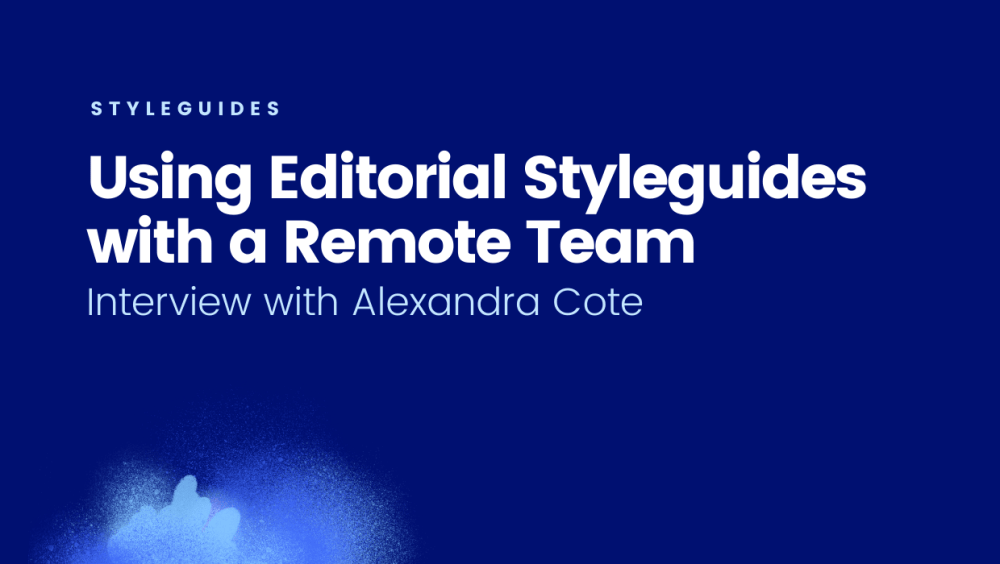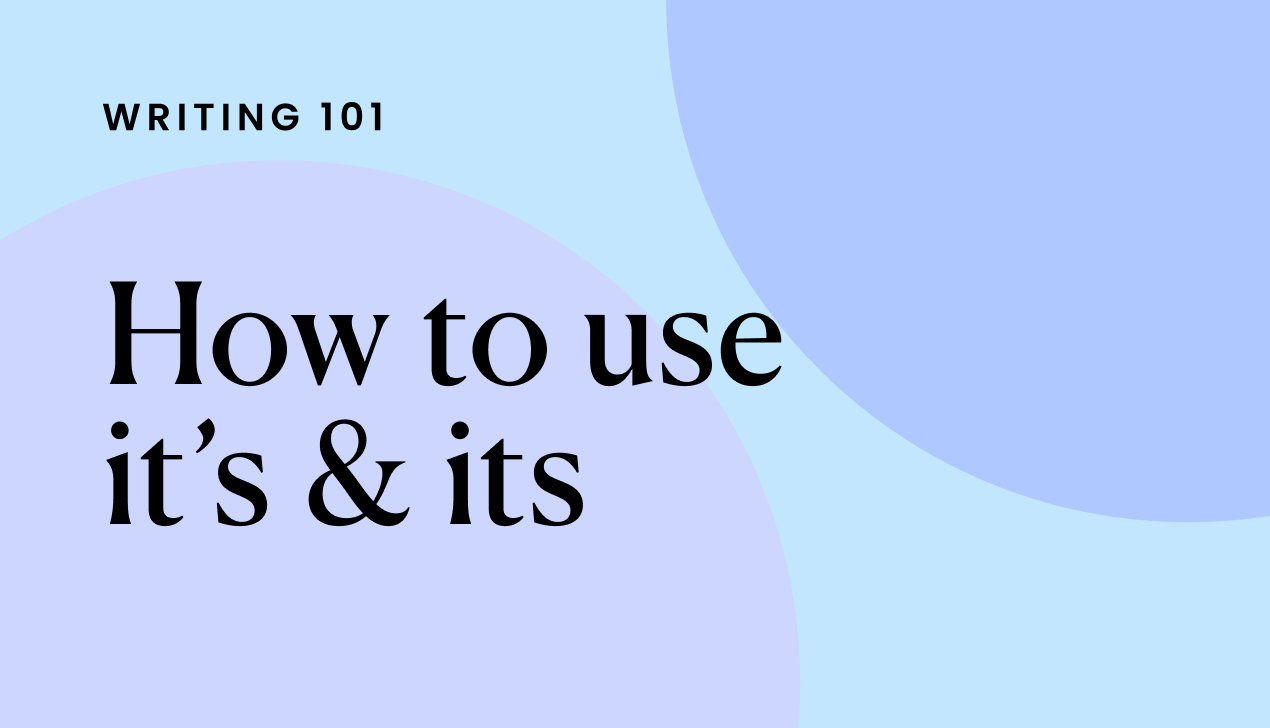Words at work
– 12 min read
Using editorial style guides with a remote team: interview with Alexandra Cote

In the face of COVID-19, many companies have moved to an all-remote workforce. It’s been a huge shift in how we think about collaboration and manage ongoing projects. It also often points out holes in documentation and processes, as companies realize they’re not yet properly setup to support fully remote workers.

Which is why today we’re sharing an interview with Alexandra Cote, who has been working with remote teammates and freelance writers for years. Alexandra is a digital marketer at Paymo and a freelance content writer and strategist for SaaS and marketing brands. She’s written for publications such as Business 2 Community, Thrive Global, and the Product Marketing Alliance. For her side passions, she’s currently teaching digital marketing and content writing to over 26,000 students on Udemy and Skillshare and runs her own YouTube channel.
Her main interests lie in content marketing, social media marketing wonders, and artificial intelligence. Alexandra’s also a strong supporter of helping people find a career that will make them happy and maintain their wellness at work. Reach out to her on Twitter @cotealexandra11 or via her blog.
Q&A with Alexandra Cote, digital marketer and content writer
1. Thanks for taking the time to talk about your work with style guides! First, can you introduce yourself and a brand whose style of writing you love or feel inspired by?
Alexandra here. 👋 I currently work full-time at Paymo. I also do freelance content writing and strategic content planning to help SaaS and marketing companies rank higher on Google (or “break the search” as I like to say). I commonly write on topics such as marketing, management, remote work, mental health at work, productivity, workplace issues, and employee wellness.
My main business goal is to see everything I write in the top search results for a specific keyword. It requires a lot of research and effort put into every single piece of content. Naturally, I expect the same input from guest bloggers who are looking to share their insights via our blog.
I’ll share two examples of content styles that inspire me. First, there’s Brian Dean. Clean, straight to the point, and consistent ideas AND layout. Mainly due to the fact that he writes all the content himself. You know how they say UX also applies to articles? Well, I think he’s the example of articles structured to perfection. Everything he writes is so easy to follow, with lots of white space, bulleted lists, headings, and, most importantly, supporting images.
My second example must be Ahrefs. They rarely accept guest posts but all of their writers tend to stick to the same guidelines. In many ways I see lots of similarities between the two examples I’ve given. Those are the styles I prefer, and I know it’s not just me. Most of my clients are content skimmers like I am and would rather read headings and bullet points instead of large chunks of text with no emojis or other fun elements.
2. What does your content creation process look like?
It really depends on who I’m writing for. If it’s an article I write for my blog, I usually just get straight to writing based on a spontaneous idea I had. Any idea that pops into my mind and makes me think, “Man, this is genius!” I write down in a Google Docs file. (Don’t do what I did and try to organize them by topics or you’ll end up with a mess of ideas.) Sometimes I take these ideas and pitch them to industry publications or brands looking for guest posts on those matters.
When I write for a client, it’s totally different. You can’t just write for the pleasure of getting your ideas out there with no other goal. Your client expects to get profitable results out of that post. More leads, increased traffic, a lower bounce rate, anything like this. So here are the general steps I go through in this exact order:
- Client meeting to understand their pain points, target audience, and key goals with their existing or future content marketing strategy.
- General topic or keyword research based on industry standards and competitor activity.
- Creating the structure for the article and deciding on a final main keyword to target. At this point I also add in my secondary keywords, but they can change during the writing process.
- After the client’s final OK, I get to writing the article. This part includes extra research, report analysis, interviews, reaching out to industry experts to feature their insights, or whatever else might be needed for a specific keyword.
- Then, I send in the draft for the client to review, put together any extra materials like images or tweets based on the article, and do the final tweaks.
That seems like a short process. In reality, all of it can take days, sometimes even months. Moreover, it doesn’t even end here. After I’m done with this it’s time to promote it. For many years to come.
3. Why do you feel an editorial style guide is important for writers?
A freelance writer or guest poster is dead without a style guide. I say this as someone who manages them and someone who is one. It’s very hard to use a voice and match the editor’s needs without one.
[click_to_tweet tweet=”‘It’s very hard to use a voice and match the editor’s needs without a style guide.’ –@cotealexandra11″ quote=”It’s very hard to use a voice and match the editor’s needs without a style guide.”]
A style guide is there to tell you exactly what you’re supposed to do and what you can’t do. It sets the stage for content writing and your brand positioning. Style guides give writers the answers they need without having to ask the blog owner or editor dozens of questions. And they keep writers from writing something a company just won’t accept. I’ve had so many people send in ready-made drafts which were obviously not a good fit for us.
[click_to_tweet tweet=”‘A style guide sets the stage for content writing and your brand positioning.’ –@cotealexandra11″ quote=”A style guide sets the stage for content writing and your brand positioning.”]
The worst — and this is something that saddens me all the time — is that many writers don’t read the guidelines even when I tell them to do so carefully. As a result, their posts just get refused or they have to restructure the entire article.
Unfortunately most companies don’t have a style guide. Usually, it’s only the brands that are well-known for collaborating with freelancers that provide the right resources — those include an editorial style guide, media kit, and any other info, case studies, or reports they might need to reference.
[widget id=”sow-editor-7″]
4. When and why did you create your first style guide?
The first style guide I put together for Paymo was owned by our marketing group. We needed something internally to help the three writers on the team maintain a similar voice and structure in the work we were actively publishing. Once you know what is expected of you, it’s much easier to deliver something close to the needs and prevent those back-and-forth edits and comments and more edits and more comments… 🙄
As we started getting more inquiries about guest post opportunities, I created style guidelines specialized for contributing authors. I researched more best practices and made sure to cover things that were extremely important to us, such as article length and amount of research that needs to be put into the final piece.
5. People often worry about what’s “worth including” and what’s not. What’s included in your style guide today?
- Info on our audience (definitely a must for someone who doesn’t know much about your brand)
- Topics we usually cover
- Detailed list of content and topics we don’t accept
- Written content standards (e.g. length, attribution rules, linking, structure, etc.)
- Image sizes and rules
- Important disclaimers (like not sending plagiarized content and reserving the right to change certain parts of the article to keep it up-to-date)
- Brief info on how the guest post process works (this is not mandatory for everyone to include in their style guide, but I want the blogs I write for to tell me exactly what’s going to happen next, so I let our guest posters know)
As for the voice, that’s difficult to impose upon a writer who has their own way of talking and, consequently, writing. This being said, I tend to keep an individual’s particularities and just focus on making the content structure work for our brand.
6. How do you make decisions for your style guide?
I must say, I’ve updated the guidelines several times. I often add more detail after someone reaches out to us with questions.
One issue early on was that I wanted all posts to have at least 2,500 words. (I’m obsessed with long-form content. 😅) It was scaring most writers. Now the minimum is down to 2,000.
Through multiple updates like these, plus checking out what others we’re doing, we arrived at our current version. It’s definitely not the final one. Currently, I’m thinking of how to make it shorter or more scannable so whoever gets it won’t skip important information. But the editor in me thinks everything’s important. 🤦♀️ I just want to create something that makes our writers feel like everything’s manageable.
[click_to_tweet tweet=”‘I want to create a style guide that makes our writers feel like everything’s manageable.’ –@cotealexandra11″ quote=”I want to create a style guide that makes our writers feel like everything’s manageable.”]
7. Have you seen the usage of your editorial style guide positively change content writing or business outcomes?
DEFINITELY! 🙏
To be honest, the first thing it helps with is that I don’t have to spend my time writing out all our guidelines over and over again. I used to do this, and even tailor them a bit to the person who inquired. Now I just send them a link and wait for their feedback. I don’t get questions like, “What was the image size you needed?” or, “Is 1,000 too short?” anymore.
[click_to_tweet tweet=”‘A style guide means I don’t have to spend my time writing out all our guidelines over and over again.’ –@cotealexandra11″ quote=”A style guide means I don’t have to spend my time writing out all our guidelines over and over again.”]
It also helps unify our blog’s style and even the topics we tackle. As a result, we’ve had writers from entirely different industries manage to unite their expertise with the values we promote.
Finally, I see the style guide as a type of contract. Our contract clearly mentions we might change things in the article, so no one can come back to us and complain about updates. Of course, since a contract goes both ways, we also provide some guarantees for the writer. In particular, we never remove the links to their website or blog once we’ve agreed to publish their work. Win-win situation.
8. Any advice for people who are working on creating a style guide for the first time?
The first thing you need to do is think about your must-haves. Beyond anything your competitors are doing or any industry standards you think you have to live up to, consider your own needs. Do you want your writers to take care of the images? Do you want all guides to be 5,000 words? Mention it all, and back up your decisions with a good reason. Make sure to include sections for the things that matter most to you and your readers.
[click_to_tweet tweet=”‘Make sure to include style guide sections for the things that matter most to you and your readers.’ –@cotealexandra11″ quote=”Make sure to include style guide sections for the things that matter most to you and your readers.”]
I also advise you to always include at least a few details on who will read the content — your audience. General info like their industry and more specific info like their challenges. It will help the writer connect their work to those pain points, so they provide an altogether handier piece of content that people will actually want to read.
You know how so many brands focus on spelling rules and fonts and colors and all that? I say only include those rules if they’re representative of your brand’s style of writing. For example, maybe you want emojis to be used specifically, or maybe you prefer every paragraph to be no longer than two sentences.
Also: add your own branding (at least logo) to the guidelines. It helps writers easily identify them, and makes them look oh so professional. ⭐️
9. Any final words of advice for people who are trying to decide if they need a style guide at all?
You need a style guide in all situations. Even if you don’t see its purpose right now, it will save you a lot of time down the line. Whether you’re creating it for your company or a personal blog, it creates unity. In time, the voice and style you create will contribute to your growth as an industry leader.
[click_to_tweet tweet=”‘You need a style guide in all situations. Even if you don’t see its purpose right now, it will save you a lot of time down the line.’ –@cotealexandra11″ quote=”You need a style guide in all situations. Even if you don’t see its purpose right now, it will save you a lot of time down the line.”]
Thought leadership and being seen as a trustworthy source is what everyone strives for. And, believe it now or not, your editorial style guide is one vital piece of your entire marketing strategy and positioning.






